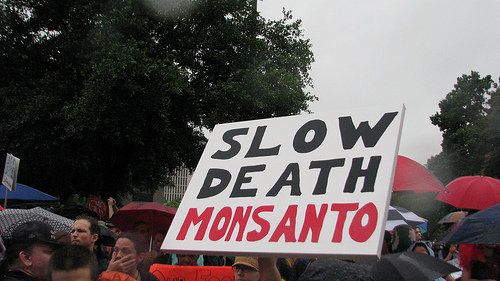
Monsanto Knew of Glyphosate/Cancer Link 35 Years Ago
According to evidence unearthed from the archives of the EPA (Environmental Protection Agency) in the United States, it has been established that Monsanto was fully aware of the potential of glyphosate to cause cancer in mammals as long ago as 1981.
Recently the WHO's International Agency for Research on Cancer (IARC) issued a statement in which glyphosate (the main component of Roundup herbicide) was classified as "probably carcinogenic" to humans and as "sufficiently demonstrated" for genotoxicity in animals.
April 8, 2015 | Source: GM-Free Cymru | by
According to evidence unearthed from the archives of the EPA (Environmental Protection Agency) in the United States, it has been established that Monsanto was fully aware of the potential of glyphosate to cause cancer in mammals as long ago as 1981.
Recently the WHO’s International Agency for Research on Cancer (IARC) issued a statement in which glyphosate (the main component of Roundup herbicide) was classified as “probably carcinogenic” to humans and as “sufficiently demonstrated” for genotoxicity in animals (1). This announcement of a change to toxicity class 2A was given vast coverage in the global media, causing Monsanto to move immediately into damage limitation mode. The corporation demanded the retraction of the report, although it has not yet been published! Predictably, there was more fury from the industry-led Glyphosate Task Force (2). This Task Force also sponsored a “rebuttal” review article (3) from a team of writers with strong links with the biotechnology industry; but because of the clear bias demonstrated in this paper (which suggests that glyphosate has no carcinogenic potential in humans) it is best ignored until it has been carefully scrutinized by independent researchers (4).
With Monsanto continuing to protest that glyphosate and Roundup are effectively harmless (5) if used according to instructions, in spite of accumulating evidence to the contrary, we undertook a search through Environmental Protection Agency (EPA) records with a view to finding out what was known about glyphosate at the time of its initial registration. This followed up earlier investigations by Sustainable Pulse which highlighted a sudden change in the EPA view on toxicity in 1991. What was discovered was very revealing. There were many animal experiments (using rats, mice and dogs) designed to test the acute and chronic toxicity of glyphosate in the period 1978-1986, conducted by laboratories such as Bio/dynamics Inc for Monsanto and submitted for EPA consideration. Two of these reports relate to a three-generation reproduction study in rats (6) (7), and another is called “A Lifetime Feeding Study Of Glyphosate In Rats” (8); but like all the other older studies they were and still are treated as Trade Secrets and cannot be freely accessed for independent scrutiny. That in itself is suggestive that the studies contain data which Monsanto still does not wish to be examined by experts in the toxicology field. It is also deeply worrying that EPA acceded to the routine Monsanto requests for secrecy on the flimsiest of pretexts.
However, archived and accessible EPA Memos from the early 1980’s do give some indications as to what the rat studies contain (9). Although the studies predate the adoption of international test guidelines and GLP standards they suggest that there was significant damage to the kidneys of the rats in the 3-generational study — the incidence of tubular dilation in the kidney was higher in every treated group of rats when compared to controls. Tubular dilation and nephrosis was also accompanied by interstitial fibrosis in all test groups and in some of the lumens the researchers found amorphous material and cellular debris. Less than a third of the control rats showed signs of tubular dilation. In the rat study results, the changes in the bladder mucosa are significant because metabolites, concentrated by the kidneys, have led to hyperplasia that could be considered as a very early and necessary step in tumour initiation. EPA was worried in 1981 that these indications were sinister, and at first declined to issue a NOEL (no observed adverse effect level) — it asked for further information and additional research. In its 1982 Addendum, Monsanto presented evidence that minimised the effects and confused the data — and on that basis EPA accepted that glyphosate was unlikely to be dangerous. But Monsanto knew that scrutiny of the data in the studies would potentially threaten its commercial ambitions, and so it asked for the research documents concerned to be withheld and treated as Trade Secrets. So there was no effective independent scrutiny. Monsanto and EPA connived in keeping these documents away from unbiased expert assessment, in spite of the evidence of harm. (It is clear that EPA was thinking about carcinogenic effects — it knew in 1981 that glyphosate caused tumorigenic growth and kidney disease but dismissed the finding as “a mystery” in order to set the NOEL for the chemical and bring it to market.)
In the rat studies, the glyphosate doses fed to the test groups were 1/100 of those used in a later mouse study (9). It is unclear why these very small doses were decided upon by Monsanto and accepted by EPA, since there must be a suspicion that the studies were manipulated or designed to avoid signs of organ damage. In its 1986 Memo, EPA remarked on the very low doses, and said that no dose tested was anywhere near the “maximally tolerated dose.” Then the Oncogenicity Peer Review Committee said: “At doses close to an MTD, tumours might have been induced.” A repeat rat study was asked for. However, BioDynamics (which conducted the research for Monsanto) used data from three unrelated studies, which they conducted in house, as historical controls to create “experimental noise” and to diminish the importance of the results obtained by experiment.
